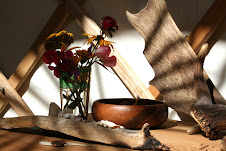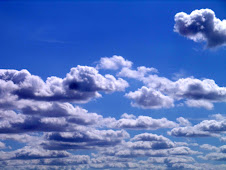Lughnasadh - the Harvest festival in honour of Lugh/Llew, the Sun God.
The Christian church recycled Lughnasadh as the feast of Lamas, a word meaning "loaf mass" from the Anglo-Saxon "hl af-masse". Traditionally on this day a new loaf of bread was offered at mass as the first-fruit of the harvest. In the old days bread was truly your harvest fruit - you tilled the land, planted the grain and watered to soil to make it grow - the making of the Lamas/Lughnasadh loaf was packed with mystical symbolism.
The bread-maker and those who ate it were acutely aware of their relationship with Mother Earth - a relationship not of words but of conscious interaction. Just like the Sun God whose heat has nourished its growth, the grain that goes into bread must be cut down in its prime to be useful. Death is necessary for life to flourish, otherwise life dies. In the past humankind the world over acknowledged this relationship between death and life - harvesting grain for bread and seeds for next year's crop - through ceremonies and rituals. One of the famous ones in Britain is told in the song John Barleycorn.
There were three men came out of the West Their fortunes for to try And these three men made a solemn vow John Barleycorn must die.
The crops are ripening and will soon be cut,the fruit is swelling upon the trees and the land is about to slip into the richness of fall. The growing crop, must die each year in order for the seed to ripen and so yield the harvest.
At this time the sun God is nearing the end of his reign.
The name of the festival (pronounced loo-nus-uh) comes from the druidic festival of Lugh, the Celtic sun God. In some ancient traditions, this is the festival in which the sun God dies, usually in a ritual of sacrifice of some sort. To commemorate him, the ancient peoples of Britain and Ireland held processions, feasts, and athletic games in his honour. It makes more sense if we see this as the beginning of the hunt for Lugh - the chase that will end in the fatal cut that marks his death at Mabon (Fall Equinox), the end of the harvest. With the first cutting of the grain, this was traditionally a feast of bread.
It is tempting to see echoes of ancient human sacrifice, but that is not really what this time is all about. The god does not really die, he continues in the form of next year's growth, he continues in the form of the food and drink he provides for people's sustenance against the coming winter. So who (or what) is it, that is being killed?
What is being killed is the child, to make room for the man.
The period of growth is ended and it is time for the completion of a purpose.
This must happen in all our lives. At one level, we must always remain children, for we never stop learning, we never stop growing. But at another level, we reach a plateau in our development, we step over into a new phase of existence.
In our late teens or early twenties we reach a stage of development of our physical bodies that we call adult. With our new status we acquire certain responsibilities: there are certain aspects, freedoms and liberties, of our childhood that we must lay aside forever so that we may properly fulfil our new role.
So in later life, we reach a state of mental and spiritual growth where we may stop growing for a while and start to make more use of our more developed faculties, for the benefit of others. This is not merely a right, but it is a duty, aresponsibility.
What is all your knowledge and spiritual insight for, if it is not to be used?
Thus, for example, one of us teach. Another may heal. Someone else may be a writer, or an artist, and so on. Some of you may still be looking for your path, not yet quite certain of the way to go on your spiritual journey. This particular time of year, Lammastide, is a good time to be looking for those answers. If you already have the answers, then it is time to put them fully into action.
It is the time of maturity,
of completion of growth,
of the final step towards attainment of purpose
It is an ideal time for completion of projects. Also, like the other major festivals of the old pagan calendar, it is considered to be a time when the veil between our world and the other worlds, the worlds of the spirit, is particularly thin, it especially benefits those projects that are spiritual in nature.
visualisation exercise with the object of bringing about a certain state of events, perhaps to help someone in difficulties or maybe to sort something out in your own lives. This kind of visualisation is usually concerned with the early stages of a project, with getting something off the ground, to a point where you can consciously take over and continue the good work by your own efforts, without the help of outside forces. Then, eventually, your project reaches a state of maturity and you can, indeed must, take on full responsibility for it, just as you take on responsibility for your life when you reach adulthood. But sometimes bringing a project to its intended conclusion can be as difficult as initiating it in the first place. It is not unreasonable for us to request help from higher forces. If the project is worthy, help will be granted. But, you have to ASK.
So, do you have a project that is about to come to fruition, which maybe needs a little final push to get it there? Or, if you are still seeking a direction, is it time that the direction became clear to you? These things are what we will seek to put in hand today, by means of our visualisation.
Lughnasadh: Prepare yourself for meditation in the usual way. Sit comfortably and relaxed. Close your eyes. Take a few deep breaths to cleanse your body and mind of everyday cares and concerns.
So, do you have a project that is about to come to fruition, which maybe needs a little final push to get it there? Or, if you are still seeking a direction, is it time that the direction became clear to you? These things are what we will seek to put in hand today, by means of our visualisation.
Lughnasadh: Prepare yourself for meditation in the usual way. Sit comfortably and relaxed. Close your eyes. Take a few deep breaths to cleanse your body and mind of everyday cares and concerns.
Visualise yourself in the countryside, on a warm summer afternoon, surveying a field of ripe, golden wheat. Think about how it will shortly be harvested and baked into delicious fresh bread. Enjoy the beauty of the moment.
Now turn your thoughts to your project, or your question. Form it clearly in your mind, with every detail of where you stand at the moment, and of how you came to be where you are.
Make sure you have every detail of your situation clear in your mind.
Now visualise a successful outcome. What is necessary to complete your project, or to give a satisfactory answer to your question? Let this, too, form clearly in your mind.
Now, quickly dismiss the pictures you have formed in your mind into the ether, and return to normal consciousness. Your petition will be dealt with. Do not think any further about your project or your question for a little while, perhaps a few days, and then the answer or the resolution will come to you.
Now is an appropriate time to take a little refreshment, something to eat and drink. Take a biscuit, or a cookie, or a piece of bread, and break it. As you do so, think of those people in the past, who would celebrate with the eating of new bread, the coming of the first harvest. Feel close to them, and feel close to the time of year, the time of coming to fruition. Then eat in silence, and sip the drink.
Take a few hours, or a few days, to absorb the significance of this meditation. If you wish, you may repeat the meditation several times during the period around the Festival .


























No comments:
Post a Comment